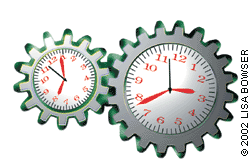
The best strategies first help you identify what really matters to you in life.
Fam Pract Manag. 2002;9(3):64

Many of the time management tips we experts have been recommending over the years simply aren’t effective anymore. For example, “prioritize your to-do list by A, B and C”? Chances are slim to none that you’ll ever get to the Cs. Technology has quickened the pace of our lives to the point that we can’t possibly do it all. Lag time has virtually disappeared. People expect answers now, not next week. So what can you do?
Find your 20 percent
One of the best time management techniques I can offer you is to help you make some decisions about how you really want to use your time. The old 80/20 rule of time management, which says that 20 percent of your efforts produce 80 percent of the results you want, is more relevant than ever today. [See “The 80/20 Rule of Time Management,” FPM September 2000, page 76.] The trick to having ongoing satisfaction is to focus on the things you value most – your “20 percent.”
To identify your 20 percent, ask yourself what aspects of your professional and personal life have the most value to you. Write down your answers as a reminder to yourself. For Gordon Moore, MD, the doctor-patient interaction is the foundation of the excellent patient care he wants to provide [see page 25]. He designed his new practice around that value, and his satisfaction has risen dramatically.
Simplify
Once you’ve identified your 20 percent, the next step is to start prioritizing your life so that you can spend the majority of your time doing what’s important to you. This requires getting rid of what’s not essential. For example, is serving on that committee something you could give away and not miss? When faced with requests for your time, ask yourself if the task aligns with your 20 percent. If it does, it’s important to you and you need to be doing it. If it doesn’t, start saying “no” without guilt. Of course, you’ll never be able to get rid of every task that’s not in your 20 percent. But you can (and should!) negotiate requests on your time so that the tasks that are most important to you don’t always get put on the back burner. [See “Protecting the Time You’ve Got,” FPM July/August 2001, page 60.]
Show up
Once you’ve decided what to devote your time to, commit yourself to being “in the moment” as you do those things. In other words, show up physically and emotionally. The many pressures on our time have taken this natural ability away from us. That’s unfortunate, since it’s probably what your patients – and very likely, your family – want from you more than anything else. Being in the moment, or “showing up,” is difficult, but it will increase your satisfaction with life. How do you do it? First of all, you have to want to show up. Then, you have to focus your energy on it and practice it often.
For example, when I speak on time management, I use the few minutes preceding my talks to learn the names of as many people in the audience as I can, and then I call people by name throughout my presentation. In addition to being an effective communication technique (it shows I’m interested in that person and often stimulates that person’s interest in what I have to say), it’s my way of “showing up” and putting myself in the moment. It forces me to be fully engaged with the people and events going on around me and keeps me from just going through the motions.
This technique works as well one-on-one as it does with an audience. Most of you probably greet your patients by name when you enter the exam room, but how many of you repeat the patient’s name throughout the exam? You may want to try doing this several times throughout your next patient visit.
Let go
Today we live in a world where there is too much to do and never enough time to do it. So why not let go of the notion that one day all the “C” items on your to-do list are finally going to get done? Instead, focus your energies on determining what is most important to you and manage your time accordingly. Only then can you really begin to manage your time and find more satisfaction in your life.